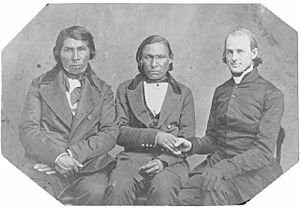Enmegahbowh facts for kids
Enmegahbowh (born around 1820, died June 12, 1902) was a very important Native American leader. His name, Enmegahbowh, means "He that prays while standing." He was also known as John Johnson. He made history as the first Native American to become a priest in the Episcopal Church in the United States.
Enmegahbowh was born around 1820 in Canada. He was the only child of an Ojibwe chief. His family lived near Rice Lake, close to Peterborough, Ontario. Some people think he was part of the Odawa tribe because his group stayed behind.
He grew up in a Christian Anishinaabe (Ojibwe) village. This village was connected to the Methodists. A church leader, Mr. Armour, convinced Enmegahbowh's parents to send him to school. He learned to read and speak English. But after three months, he missed his home. He ran away and walked for two days to return to his family.
Around 1831, Enmegahbowh's grandfather taught him about the Midewiwin. This was a special tribal religious group.
Contents
Becoming a Christian Leader
On July 4, 1841, Enmegahbowh married Charlotte. She was also known as Biwabikogeshigequay, or Iron Sky Woman. She was the niece of a chief named Hole-in-the-Day the elder.
Enmegahbowh met Reverend Ezekiel Gilbert Gear. Gear was a chaplain at Fort Snelling. This fort was where the Mississippi and Minnesota Rivers meet. Enmegahbowh became an Episcopalian because of him. Gear later introduced Enmegahbowh to Reverend James Lloyd Breck. Breck was a missionary who came to Minnesota in 1851. He baptized Enmegahbowh.
In 1859, Bishop Jackson Kemper made Enmegahbowh a deacon. A deacon is a church leader. Enmegahbowh then went to Crow Wing, Minnesota. He helped start the St. Columba Mission there. Chief Fine-Day of the Mille Lacs Indians was an early member of Enmegahbowh's church. Chief Fine-Day took over the mission in 1861.
Enmegahbowh's Role in the Dakota War
In 1851, the Dakota people signed two treaties with the U.S. government. These were the Treaty of Traverse des Sioux and the Treaty of Mendota. Through these treaties, the Dakota gave up millions of acres of land. This allowed white settlers to move into Central and Southern Minnesota.
In return, the Dakota were promised a reservation and yearly payments. These payments were supposed to be over two million dollars. However, they received very little money. Most of the money went to white traders or was stolen. This happened because of corruption in the Bureau of Indian Affairs.
When Minnesota became a state in 1858, the tribes sent leaders to Washington, D.C. Chief Little Crow led them. They complained about not getting their promised payments. But they did not have much success. The land on their reservation was not good for farming. New settlement rules also made it hard to hunt.
Preventing More Conflict
The Dakota War of 1862 began when the Dakota were starving. They were waiting for treaty payments at Fort Ridgely. At the same time, the Gull Lake Band of Ojibwe, led by Chief Hole in the Day the Younger, planned to attack Fort Ripley.
Enmegahbowh bravely stopped other Ojibwe bands from joining the attack. Because of this, Chief Hole in the Day imprisoned him. But Enmegahbowh escaped. He traveled thirty miles at night to warn Fort Ripley. His warning stopped the Gull Lake Band from attacking the fort.
Many Ojibwe people were upset with Enmegahbowh for years. But he stayed with his people. He followed them when they moved to the Leech Lake Indian Reservation. Later, they moved to the White Earth Indian Reservation.
Later Life and Important Work
In 1867, Bishop Henry Benjamin Whipple ordained Enmegahbowh as a priest. This was a very important step. In 1869, Enmegahbowh encouraged Chief White Cloud. He helped the chief work for peace between the Ojibwe and the Sioux tribes.
In March 1880, Enmegahbowh and Chief Fine-Day traveled across the eastern United States. They spent three months raising money. They wanted to build a new St. Columba Episcopal Church at White Earth.
While in Ohio, they met the governor. They also spoke to the Ohio state legislature. They raised $6,000 for their church project. After Chief Fine-Day died in 1883, Enmegahbowh called him "our noblest chief." He suggested a stained glass window in the church to remember him.
Death and Lasting Legacy
Enmegahbowh died on June 12, 1902. He was 95 years old. He passed away at the White Earth Indian Reservation in northern Minnesota. He is buried in St. Columba's churchyard.
The people of St. Columba's honor him every June. They do this during the White Earth Pow-Wow. The Episcopal calendar of saints remembers Enmegahbowh on June 12.
Owanah Anderson wrote about Enmegahbowh in her book. She said that church historians often did not give him enough credit. She stated that Bishop Whipple helped start Christianity for the Ojibwe. But Enmegahbowh was the one who made it happen. He was the bishop's loyal friend and helper for over 40 years.
Enmegahbowh is remembered at St. Mark's Cathedral in Minneapolis. There is a special place there called the Enmegahbowh Healing and Reconciliation Station.



